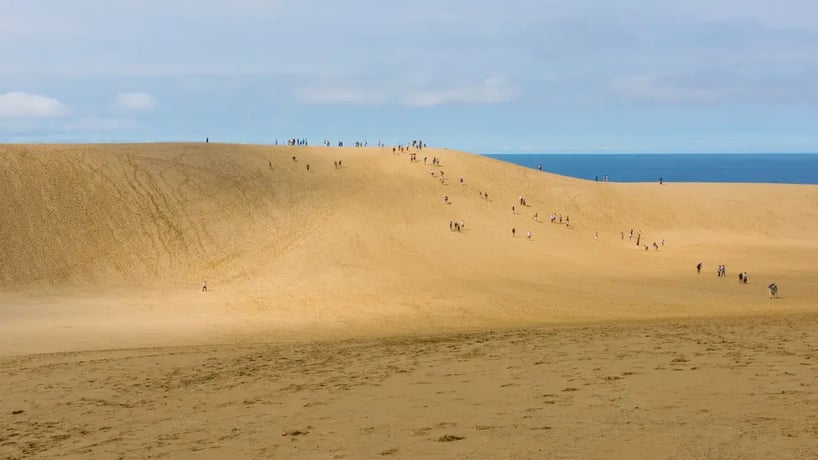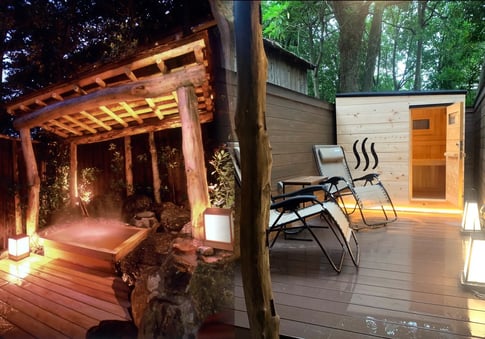🕓 2025/7/17
#ホテル

Table of Contents
About Tottori Prefecture
Tottori Prefecture lies on the Sea of Japan side of Japan’s Chūgoku region and is a captivating area where sweeping dune landscapes, deep‑blue seas, and abundant bounty from both mountains and ocean come together. Historically known as the provinces of Inaba and Hōki, the prefecture boasts scenic treasures such as the Tottori Sand Dunes, the rugged Uradome Coast, and the sacred peak of Mount Daisen. These sites preserve striking wind‑carved patterns, unusual rock formations, and a rich history of mountain worship. Visitors can enjoy sand‑board adventures on the dunes or follow ancient pilgrim paths at Ōgamiyama Shrine, the ichinomiya of Hōki Province.
For sightseeing, Tottori offers a wealth of natural and cultural attractions: the radium‑rich waters of Misasa Onsen, the seaside baths of Kaike Onsen, and Hakuto Coast, famed as the setting of a Japanese myth. Seasonal delicacies also entice travelers—Matsuba crab in winter and the celebrated 20th‑Century pear in autumn are just two examples of the region’s culinary allure.
Below are three carefully selected luxury ryokan that promise an exceptional stay when you visit Tottori Prefecture.
3 carefully selected Japanese-style inns in Tottori Prefecture
1. Roman Denshō‑no‑Yado Akashiya
 出典: 明石屋 公式HP
出典: 明石屋 公式HP
■ The Appeal of Roman Denshō‑no‑Yado Akashiya
Founded in 1615: an outline and its historical significance
Roman Denshō‑no‑Yado Akashiya is one of Tottori Prefecture’s most venerable ryokan, established in Genna 1 (1615) at the dawn of the Edo period. For more than four centuries it has safeguarded the spirit of Japanese hospitality, refining it across the ages. That longevity is not merely a matter of age; it stands as proof of a tradition honed by time.
1. A ryokan that weaves four hundred years of tradition

The inn’s greatest allure is its history of over four centuries. More than a place to stay, it is a living museum of ryokan culture where the timeless spirit of omotenashi, passed from generation to generation, permeates every corridor. Among the inns of Iwai Onsen, Akashiya commands an especially storied presence.
2. San‑in’s oldest class of water—pure Iwai Onsen, flowing direct from the source

Since its founding the inn has adhered to gensen kakenagashi, natural hot‑spring water that is neither diluted nor reheated. Iwai Onsen itself is the San‑in region’s oldest spa, boasting a history of more than 1,200 years. Guests may immerse themselves in these ancient waters in a large bath built of natural materials and in a garden open‑air bath created about fifty years ago with rare Saji stone—said to be the oldest rotenburo in Tottori. The baths are open twenty‑four hours a day.
3. No two rooms the same: guest quarters with individual character

From special rooms with private open‑air baths to standard tatami‑matted spaces, every guest room is laid out and decorated differently. Each visit thus offers new discoveries and a fresh sense of travel. Rooms with private rotenburo expand the possibilities for those who wish to enjoy the springs in complete privacy.
4. Kaiseki cuisine that celebrates the bounty of Inaba

Under the theme “Mountain and Sea Delicacies of Inaba,” the kitchen presents lavish courses featuring the region’s seafood and seasonal vegetables. Skilled chefs work with locally landed fish and farm‑fresh produce. In winter, guests can savor a full course built around tag‑certified Matsuba crab; at other times of year, prime Tajima beef steak and similar seasonal specialties appear. The menu reflects deep respect for the blessings of the land.
5. An onsen town steeped in nostalgia

A streetscape of early‑Shōwa wooden buildings, the murmur of the Gamo River, and the preserved look of old Iwai Onsen create an atmosphere in which time seems to have stopped. The novelist Shimazaki Tōson once stayed here, adding to the inn’s literary cachet. In recent years fans of an anime series set in Iwami Town have come on “pilgrimage,” adding a modern layer of charm, yet the essential mood remains that of Japan’s unhurried rural past.
■ Access to Roman Denshō‑no‑Yado Akashiya

- Official Website: https://akashiya.to/
- Access: Complimentary shuttle service from JR Iwami Station
- Address: 536 Iwai, Iwami‑chō, Iwami‑gun, Tottori 681‑0024, Japan
- Google Maps:https://maps.app.goo.gl/HWK7rEmMwh5Yup3F6
2. Iwaiya, Iwai Onsen
 出典:岩井屋 公式HP
出典:岩井屋 公式HP
■ The Appeal of Iwaiya, Iwai Onsen
Warmth Gained Over Time: Overview and Atmosphere
Iwaiya is a three‑story wooden ryokan with a history of roughly 150 years. Located in the same hot‑spring village as Akashiya, it offers a more intimate, rustic ambience. The entire building is floored with tatami, and there are only thirteen guest rooms. Avoiding ostentatious décor, the inn preserves the feel of an old‑style hatago that prizes harmony with nature.
1. San‑in’s Oldest Waters, Flowing Directly from the Source

Iwai Onsen, whose springs have bubbled for 1,200 to 1,300 years, is regarded as the oldest hot‑spring area in the San‑in region. Iwaiya serves this precious water as natural, free‑flowing gensen kakenagashi, neither diluted nor reheated. Of special note is “Chōju‑no‑Yu,” where the spring rises directly beneath the cedar planks lining the bath floor—a rarity that lets bathers feel the freshness and energy of the source itself. Even the taps dispense spring water. Other options include the open‑air “Seto‑no‑Yu” and “Iwai‑no‑Yu,” as well as the private bath “Yoimachigusa,” offering a variety of bathing experiences. The spring emerges at a fairly hot 50 °C.
2. The Ancient Custom of Yukamuri

Iwai Onsen maintains a unique bathing ritual called yukamuri. Guests place a small towel on the head and ladle hot spring water over themselves while soaking—a practice thought to be a remnant of traditional therapeutic bathing. Although the documents provided give few details, the very existence of yukamuri symbolizes the deep history and culture shared by Iwai Onsen and Iwaiya.
3. An Interior Wrapped in the Warmth of Mingei Craft

The inn’s design reflects the Mingei folk‑craft spirit for which Tottori is known. Pottery from local kilns and Tottori Mingei furniture—simple yet imbued with functional beauty—are placed unobtrusively throughout the building, creating a warm, soothing atmosphere. Combined with the all‑tatami floors, the setting immerses visitors in Japan’s traditional aesthetic, as though time itself has turned back.
4. Hospitality Expressed through Seasonal Inaba Flavors

Meals center on heartfelt local cuisine that makes generous use of mountain and sea fare from the Inaba area. Spring brings mountain vegetables and mosaic squid; summer offers rock oysters and white squid; autumn features matsutake mushrooms and pears; winter, of course, highlights Matsuba crab. Kaiseki courses—such as the Inabaji Kaiseki “Tsuki” and a premium menu—focus on drawing out each ingredient’s natural flavor. Breakfast includes gentle San‑in items like grilled fish and tōfu chikuwa.
5. Intimate Japanese Rooms that Retain the Air of a Healing Resort

The thirteen tatami rooms within the historic three‑story structure each bear the name of a flower and radiate a calm, traditional charm. There is no flamboyance, but the rooms are spotless and carefully maintained, conveying the mood of an old therapeutic spa. Details such as clove‑dyed towels and tabi socks add to the appeal. When guests change into yukata and relax on the tatami, they feel genuine comfort and freedom. Modern conveniences—including Wi‑Fi and high‑tech toilets—are also provided.
■ Access to Iwaiya, Iwai Onsen

- Official Website: https://iwaiya.jp/
- Access: Take the Nihon Kōtsū bus bound for “Iwai Onsen” and alight at the “Iwai Onsen” stop; the inn is a one‑minute walk.
- Address: 544 Iwai, Iwami‑chō, Iwami‑gun, Tottori 681‑0024, Japan
- Google Maps : https://maps.app.goo.gl/vX8XWHo7RAPCuZ9U9
3. Kaike Yugetsu
■ The Appeal of Kaike Yugetsu
Toward a New “RYOKAN”: Overview and Concept
Opened in March 2019 on the seafront of Kaike Onsen in Yonago, Tottori Prefecture, Kaike Yugetsu is a modern ocean‑front property that inherits the best elements of the traditional ryokan while fusing them with contemporary sensibilities and comfort. Its guiding concept is a new style of “RYOKAN” that harmonizes heritage and modernity.
1. An Infinity Bath Where Sky and Sea Become One

The inn’s signature feature is the “Infinity Sky Open‑Air Bath” in the large communal spa. The rim of the tub is designed to merge visually with the horizon, so guests feel as though they are floating in the Sea of Japan. This spectacular bath achieved second place in a nationwide ranking by The Nikkei. The indoor area includes a dry sauna for men and a mist sauna for women, creating a resort‑like hot‑spring experience.
2. 全室オーシャンビュー、プライベート露天風呂付きの贅沢

All thirty‑two guest rooms face the Sea of Japan and are furnished with a terrace that includes a private hot‑spring bath. Accompanied by the sound of the surf, guests can soak in complete privacy—an unparalleled luxury. Most rooms are Japanese‑Western hybrids, pairing twin beds for restful sleep with a tatami space for relaxation.
3. Gastronomy and Pairings in an Ocean‑View Dining Room

Meals feature creative Japanese kaiseki that showcases the fresh seafood landed at nearby Sakaiminato. A notable highlight is the presence of both a certified sommelier and a licensed kikizakeshi (sake professional) among the culinary staff, enabling precise pairings of wine or sake with each course. Diners savor these dishes in a 43‑meter‑long restaurant that overlooks the sea; in‑room dining plans are also available. The commitment to fine cuisine and polished service is unmistakable.
4. A “RYOKAN” Style That Blends Tradition and Modern Design

Calling itself a “RYOKAN,” Kaike Yugetsu offers new value beyond the conventional inn. While preserving Japanese hospitality, the eight‑story reinforced‑concrete structure, sophisticated interiors, and on‑site spa and esthetic treatments pursue the luxury and comfort that contemporary travelers expect. The result is a modern resort that appeals to guests from Japan and abroad.
5. A Base for Enjoying Kaike Onsen and San‑in Sightseeing

Kaike Onsen stretches along the graceful arc of Yurigahama Beach and ranks among the San‑in region’s top resorts. Summer invites swimming and beach activities. Leveraging this superb location, Kaike Yugetsu is an ideal hub for strolling the hot‑spring town and for excursions to attractions such as Daisen‑Oki National Park, Sakaiminato’s Mizuki Shigeru Road, and even Izumo Taisha further afield. Access from JR Yonago Station or Yonago Kitaro Airport is relatively straightforward.
■ Access to Kaike Yugetsu

- Official Website: https://kaike-yugetsu.jp/
- Access: Approximately 15 minutes by car from JR Yonago Station
- Address: 3‑11‑1 Kaike Onsen, Yonago‑shi, Tottori 683‑0001, Japan
- Google Maps : https://maps.app.goo.gl/f2YJXaSDCNeXVGRf6

